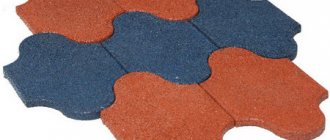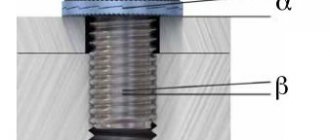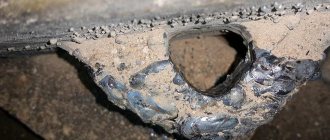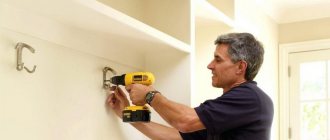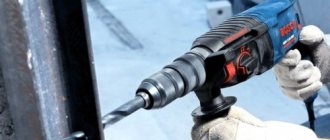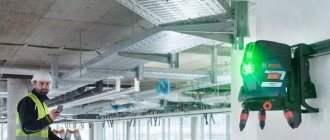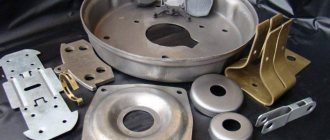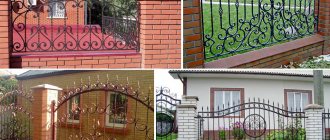Features of preparing the working composition
Regardless of the rubber coating manufacturing technology you choose, you will need:
- rubber crumb;
- adhesive composition;
- coloring pigments.
Rubber crumb
The degree of grinding of rubber tires determines their further scope of use.
- crumbs less than 2 mm in size – the formation of two-layer floor coverings for sports fields and stadiums, running tracks, swimming pools, industrial workshops, car washes, livestock buildings;
- granules 2-5 mm in size - filling sports equipment, creating a base for children's, sports and playgrounds.
When purchasing crumb rubber, pay attention to the following conditions:
- quality of product cleaning;
- sorting by size;
- crumb shape.
For 1 m2 of coating, an average of 8 kg of rubber will be required.
The crumb produced by mechanical processing of tires has smooth edges, so much less binding elements are required than when using a grated analogue.
The cost of finished crumb rubber starts from 10-12 rubles. per 1 kg of product and depends on the volume of purchase and seasonal demand for products.
Adhesive composition
For the manufacture of seamless rubber flooring, predominantly one-component compounds , less often - two-component ones.
One-component
Bitumen or polyurethane is used as a binding element in the adhesive mixture. The choice of adhesive is determined by the performance properties of the future coating and the work conditions.
Adhesive for rubber coatings on a polyurethane basis has the following properties:
- Water permeability . Water does not linger on the surface of a coating made with polyurethane, but passes through it. The finished coating can be used both indoors with high humidity levels and outdoors.
- High abrasion resistance . Suitable for making floors subject to high mechanical loads.
- Elasticity . Allows you to create an injury-proof covering for sports.
- Environmental friendliness . The absence of harmful fumes makes it possible to use rubber floors in play areas for very young children.
- Long service life due to resistance to ultraviolet radiation and sudden temperature changes.
Another feature of the polyurethane binder is hardening at a fairly high level of humidity - 60-70% and an ambient temperature of 20-25o.
Compositions with bitumen are less suitable for making a seamless rubber surface.
Bituminous components do not mix well with paint and have lower performance properties.
Cost 1 kg. one-component glue – from 185 rub.
Two-component
Two-component adhesive is sold in separate containers containing an epoxy-polyurethane binder and a chemical hardener.
Both components are mixed directly at the time of work .
When choosing a two-component adhesive for crumb rubber, you should take into account that the finished composition should be used in the first 30-40 minutes after its preparation.
This feature of the glue requires careful calculation of the need for it to carry out work in this period of time. The advantage of the two-component composition is high chemical inertness.
The cost of 1 kg of glue is from 165 rubles.
Requirements for work
The formation of a high-quality seamless rubber coating is possible only with strict adherence to the proportions recommended by the adhesive manufacturer.
For 1 kg of crumb rubber, about 250 g of polyurethane glue is required; the consumption of the binder depends on the size of the granules used.
Another condition for uniform polymerization of the working composition is maintaining the required level of humidity and temperature at the work site.
Pigment compositions
The coloring of the future rubber coating is given by coloring pigments added to the working composition.
What should you pay attention to when choosing paint?
- production from inorganic components;
- presence of iron oxides.
This component composition of the dye makes it resistant to precipitation and ultraviolet radiation , extending the aesthetic life of the coating.
The dosage of the dye depends on the desired color intensity of the surface being formed and averages 62 g per 1 kg of crumb rubber.
The uniform consistency of the working composition is achieved by strictly following the manufacturer's recipe.
The cost of 1 kg of dye is from 110 rubles.
Primer material
A polyurethane-based primer is another component without which high-quality installation of a seamless rubber coating is impossible.
The material, which has good penetrating ability, ensures high adhesion of the components of the laid mixture with the treated coating.
The price of a primer ranges from 10 rubles. for 1 kg. and depends on the volumes purchased.
Manufacturers
Polyurethane-based adhesives are presented on the market by both foreign and domestic companies, which include:
- "Titanium";
- "Anles";
- "Carbamate";
- "Desmokol";
- "Polinor";
- Henkel;
- Kenda Farben;
- Soudal et al.
These companies produce polyurethane adhesive for exterior and interior use with different compositions that provide high-quality connections and improved product properties.
Coating production equipment
The quality and durability of the future product largely depend on the equipment used in production.
The use of special mechanisms is especially important when it is necessary to produce a two-layer coating or carry out large-scale work .
You don’t have to buy equipment; you can rent the equipment you need.
Mixer
High-quality mixing of crumb rubber, glue and dye is ensured by using an industrial mixer.
Unmixed lumps in the working mixture are a manufacturing defect and can ruin all your attempts to create a high-quality seamless rubber coating.
Distinctive features of the mixing device are simple design and reliability in operation .
Let's look at some types of mixers for crumb rubber:
- device with top feed of raw materials and side unloading window;
- designs with removable tanks and overhead engine placement;
- screw mixer.
The MSRK-90 crumb rubber mixer has good reviews from the online community. The device has a top loading of working composition components and a convenient window for removing the finished mixture.
The capacity of the mixer and the power of its engine allow you to efficiently mix a mixture of 90 kg of rubber.
Autostacker
Mechanized laying of rubber coating has the following advantages :
- high labor productivity , allowing, depending on the brand of equipment used, to lay a surface area of up to 1000 m2;
- reduction in the number of personnel to carry out work;
- the ability to configure equipment to obtain coverage of strictly specified parameters;
- convenience and basic service.
The paver is an equipment equipped with an adjustable scraper at the front of the working platform, a pressure plate and heating elements at the rear of the device.
The stacker is controlled by regulating the speed and direction of its movement; there are also devices for manually moving the mechanism.
During operation, the rubber mixture spread on the rough surface is distributed and leveled by the paver over the entire width of the working area of the device. Heating elements heat the rubber mixture, thereby accelerating the polymerization process of the glue.
Stitch roller
Hand rollers for compacting the rubber-adhesive mixture must be quite heavy. Lightweight devices are not able to effectively compact the working composition , which will lead to rapid destruction of the rubber coating.
There are three types of rollers used to form rubber coatings:
- large roller for compacting the main surface area;
- roller for rolling out joints and joints;
- roller for forming surface corners.
Composition sprayer
The spray device provides technology for uniform application of the working composition to the surface being treated.
The advantage of the sprayer is the ability to hide minor “flaws” during coating production by applying a thin finishing layer of raw materials.
The operation of the equipment is carried out as follows: the composition, ready for application to the working plane, is placed in the receiving hopper.
Using a pump, the mixture is supplied under high pressure to the spray gun and applied to the surface with a layer of the required thickness; the radius of spraying the raw material is adjustable .
The equipment works well with crumbs up to 1 mm in size. A larger fraction clogs the spray nozzle and disables it.
Weighing equipment
Exact adherence to the proportions of the ingredients of the working composition is a condition for obtaining a high-quality seamless rubber surface.
It is unacceptable to use measuring containers to determine the volume of one or another component of the mixture - a deviation from the norm of 5-10% significantly reduces the performance characteristics of the finished coating.
Overview of species
Each type of glue has its own area of application and distinctive properties determined by its composition.
Polyurethane adhesive is a liquid, clear product, but sometimes has a light yellow tint. Based on the degree of viscosity, its purpose also changes.
The one-component composition hardens quickly in the open air due to natural humidity, although it does not contain a hardener. This glue is the optimal binder for the production of all kinds of rubber products: mats, carpets, rolled material, paving stones and tiles.
If you choose a two-component composition of polyurethane glue, you will have to prepare it first - mix the glue directly and the hardener supplied with it. Only after mixing them does solidification occur, and the speed of this process depends on the proportions of the two components taken.
Advantages of polyurethane compounds used for rubber:
- environmental cleanliness, safety for humans and the environment;
- high shock-absorbing qualities;
- resistance to abrasion and external negative influences;
- good water resistance;
- the possibility of coloring rubber products by introducing pigments into the composition.
These types do have a slight drawback - you need to use the glue quickly after opening the package; the beneficial properties of the material are preserved for 30 minutes.
Rubber-bitumen mastics have special characteristics. First of all, this is a low melting point, which reduces their elasticity and strength. In addition, the bitumen they contain prevents staining of the rubber.
However, in many respects this glue has advantages over polyurethane:
- the possibility of using mastic on inclined and vertical surfaces due to its good viscosity;
- protection of any base from moisture, which means preventing the development of fungus and mold stains;
- It is preferable to lay rubber on metal surfaces using a bitumen composition that has anti-corrosion properties;
- if it is necessary to make a coating on concrete, asphalt, then you should also choose mastic, since it gives better adhesion to these materials than polyurethane mixtures.
The disadvantages of glue are vulnerability to low temperatures and high consumption due to high viscosity. Thus, different types of adhesive base should be selected based on the purposes and operating conditions.
Rubber coating manufacturing technologies
Laying seamless rubber coating is accessible even to amateur craftsmen. The main requirement for the work is strict adherence to the instructions when preparing the working composition, as well as careful stirring and application of the mixture.
Single layer surfaces
Installation of the rubber coating is carried out in the following sequence.
Preparing the base
The service life of the future coating largely depends on the quality and type of base.
The most popular types of bases are:
Crushed stone . Used for installation of rubber coating on playgrounds, sports facilities intended for running and race walking.
Cost-effectiveness and moisture permeability are the main features of a crushed stone base.
The coating laid on crushed stone must have a thickness of more than 15 mm. and used exclusively for light loads.
Excavation is being carried out at the work site.
The size of the recess depends on the level of groundwater, as well as the type of soil and its drainage capacity.
The distance from stormwater wells also matters.
The next step is compacting the soil and laying drainage . Then layers of sand and crushed stone of various fractions are laid with mandatory compaction. The top layer is formed from fine screenings.
A high-quality crushed stone base has a slight slope to remove moisture, does not contain depressions or bulges, and does not press down when walking.
Asphalt. A base made of asphalt concrete mixture allows for laying crumb rubber in a layer of 1 cm. This type of base is used in the construction of professional sports facilities. Its advantage is its high strength, which can withstand the weight of special equipment.
It is recommended to carry out work on laying the asphalt base at least a week before the start of pouring the rubber mixture. The base should be formed with a slight slope to remove moisture and have no differences in height over the entire surface.
Another condition is the absence of stains from petroleum products.
The asphalt base can be formed in either one or two layers, with the obligatory arrangement of underlying layers of sand and crushed stone.
Compliance with the technology of manufacturing asphalt pavement allows you to obtain a base that can withstand significant mechanical loads.
Concrete. The concrete base is the strongest and most durable and has a universal scope of use.
Like asphalt, it can withstand heavy loads and can even be used to form floors in car parks.
A high-quality concrete coating requires effective waterproofing and grinding .
What else should you pay attention to when installing a concrete foundation?
- The thickness of the concrete layer must be more than 1.2 cm; the exact amount of concrete per 1 m2 of working area is calculated based on the type of soil and the planned loads on the foundation.
- Concrete reinforcement should not be neglected. Fine mesh wire mesh significantly improves the quality of the future foundation.
- Forming the base plane at a slope and careful waterproofing prevents delamination of the concrete layer and the accumulation of puddles on its surface.
- It is necessary to sandblast the concrete to achieve complete adhesion to the layer of rubber and glue.
- The base is considered ready when its moisture level is less than 4%.
A layer of rubber on a concrete base - from 1 cm.
Primer
To increase the “adhesive” properties of the glue to the subfloor or base, it is necessary to prime the surface.
For these purposes, you can use store-bought primer mixtures or prepare them yourself.
For the simplest primer, you will need turpentine and polyurethane-based glue. The components are mixed in equal proportions and applied with a roller to the surface to be treated.
The time it takes for the primer to “harden” depends on the level of humidity and temperature of the work site and ranges from half an hour to several hours . The mixture consumption per 1 m2 of surface is 300 g.
Calculation of components and mixing of the working mixture
Depending on the volume of the mixer tank and the power of its engine, you can immediately prepare a composition for laying on 5-10 m2 of base.
So, when gradually forming a rubber coating 1 cm thick in “steps” of 5 m2, you will need:
- Crumb rubber – 40 kg.
- Glue – 8.5 kg (see instructions for use for exact proportions).
- Dye – 2.5 kg.
The finished components are fed into the mixer tank in the following order: crumbs, after 2 minutes pigment dye. After the rubber particles are uniformly colored, glue is added to the mixer. Mixing the composition is carried out until a homogeneous mixture is obtained and, as a rule, takes 10-15 minutes.
Application
For ease of work, you can mark the working surface into segments with an area of 1 m2. A mixture weighing 10.2 kg is poured into each square. The rubber-adhesive mass is leveled over the surface using special devices in the form of spatulas and pressed down with rollers.
With the mechanized method of work, the available equipment is replaced by an automatic stacker.
Only minor defects in the finished surface, which periodically arise when using equipment over large areas, are corrected manually.
Complete sintering of the composition depends on weather conditions and averages 8-12 hours.
Double layer technology
The rubber coating can be laid in one or two layers. With a two-layer technology, you can save on painting the lower layers of rubber.
To make the coating more elastic, it is advisable to use fine crumbs (up to 2.5 m) to form the first rubber layer.
After the first layer of rubber has completely hardened, it is necessary to reinforce the surface with fiberglass mesh. This technique increases the strength of the coating and increases its service life .
The top layer of rubber coating can be formed with the addition of ready-made colored rubber granules or consist entirely of them. In this case, pigment dyes are not used.
The thickness of the top layer, depending on the purpose of using the future coating, is from 1 cm.
"Dry" floors
The technologies we have considered fall into the category of do-it-yourself installation of rubber floors using binding components. There is another method, the so-called “dry” production of rubber flooring.
The laying technology is a simple spreading of rubber crumb in a layer of more than 8 cm on the base.
This method of work is good for quickly creating a temporary floor covering, and this is where all its advantages are limited.
Polyurethane glue
This is a liquid product. Manufacturers offer a binder with a whitish, yellowish tint or completely colorless. Polyurethane adhesives are produced for various purposes. For each specific case, a material with a suitable viscosity is selected.
The method of applying the glue depends on its composition. One-component does not contain a hardener. It hardens after being exposed to air. This process is aided by moisture in the atmosphere.
Example of a popular glue
The one-component composition is used to produce various types of rubber coatings. With its help it is produced:
- tile;
- paving stones;
- mats;
- coating supplied in rolls;
- mats that are placed at the front door to clean dirt from the soles of shoes.
The one-component composition is also in demand during installation. If the material is laid on a solid base, an adhesive composition is used to prevent the elements from moving relative to each other. To do this, having previously primed the surface, apply the required amount of glue, and then lay the tiles.
Two-component polyurethane adhesive is supplied together with a hardener. When not mixed, both components have low viscosity. After they are combined, a chemical reaction occurs and the hardening process begins.
The amount of added hardener allows you to control when the composition reaches the required strength. Before use, both components are mixed in the required proportion, which is individual for each brand.
Advantages and features of glue
The composition is different:
- water permeability;
- resistance to mechanical stress, including abrasion;
- shock-absorbing properties - products made with its help have good damping characteristics;
- safe for the environment, therefore used when performing work outside the home;
- absence of solvents - as a result, the service life of the rubber coating increases.
When working with a one-component composition, remember that after opening the original packaging, the composition retains its characteristics for half an hour. The duration of the period depends on the humidity of the surrounding air.
Formation of a seamless coating
Production price
Making and installing rubber coating yourself is the most cost-effective option for doing the work. The cost of third party services varies greatly and depends on the following factors :
- purpose of the product;
- coating thickness;
- number of layers of the product.
Let us present the results of a study of the market for services for the production of seamless rubber surfaces (consumption and prices per 1 m2) in the following table:
| Purpose of coverage | Thickness, cm | Cost per 1 m2, rub. |
| Unpainted coating for outdoor and indoor playgrounds | 1,0 | 950-1150 |
| Painted coating for children's games outdoors and indoors | 1,0 | 950-1200 |
| Painted rubber coating for sports and playgrounds | 1,5 | 1300-1800 |
| Self-leveling seamless floors for berths of small vessels | 1,0 | 950-1300 |
| Covering for livestock buildings | 1,0 | 950-1600 |
| Formation of floors for warehouses and utility rooms | 1,0 | 950-1200 |
| Double-layer floors for various purposes | 1,5-3,0 | From 1700 |
It is very cost-effective to set up a paving business if you produce crumb rubber from tires yourself. Of course, to open such a business you need equipment, which can be found here.
One-component adhesive (binder)
A one-part polyurethane adhesive that cures when exposed to moisture in the air. It is used as a binder for rubber crumbs, EPDM, waste polyurethane foam and other materials to create injury-proof anti-slip surfaces. Can be used as an adhesive for rubber tiles, linoleum, as well as marmoleum and artificial grass.
Application area
- formation of seamless rough surfaces of sports and children's playgrounds, jogging and walking paths, steps of stairs, animal enclosures, piers, moorings and other outdoor objects;
- creation of smooth floor coverings indoors, including in gyms, corridors of schools and medical institutions;
- molding of piece products, such as rubber tiles and mats.
Advantages
The one-component PU binder is characterized by the following features:
- ease of use;
- high polymerization rate;
- compatibility with all types of fractionated fillers;
- excellent elasticity and strength after hardening;
- hygiene;
- resistance to wear, negative temperatures and ultraviolet radiation.
Conditions for using a one-component polyurethane binder
When using one-component adhesive, the following conditions must be met:
- ambient temperature, materials and base - from +10 to +25 °C;
- air humidity - no higher than 80%, base - no more than 4%;
- absence of dew and precipitation.
Application
For a strong and reliable connection of surfaces, it is necessary to strictly adhere to the manufacturer’s recommendations on the packaging when working.
There are 2 types of gluing:
- Hot. The connection is carried out at temperatures from +70 to +160° C, the procedure lasts only a few minutes.
- Cold. Gluing is carried out at room temperature, but the adhesive seam gains the strength stated by the manufacturer within 1-2 days.
Seam gluing
Experienced users of inflatable boats know that the seams are the weakest point. In this case, you have to deal with a tape that runs along the entire length of the seam. All places where it peels off must be treated with abrasive and degreased. Then you can apply rubber boat glue, distributing it evenly along the entire length of the seam. The two mating surfaces should be brought tightly together, ensuring fixation with a press or fingers. Such areas are difficult precisely because of the problems of alignment, since the fit will have to be maintained for several hours or even days.
Preparing the boat for repair
Proper execution of the gluing technique is no less important than the choice of adhesive. But this operation is foreshadowed by preparation. Having decided which glue is best for repairing a rubber boat in a particular case, you can begin to analyze the work ahead. At this stage, an inspection is carried out, and the parameters of cuts, holes, holes and other damage are identified. If necessary, you can use a detergent that will detect subtle defects. Next, problem areas are treated with fine-grained sandpaper. This procedure will increase the adhesion of polyvinyl chloride to the adhesive. After this, you should begin to degrease the damaged area and begin treating with glue.
